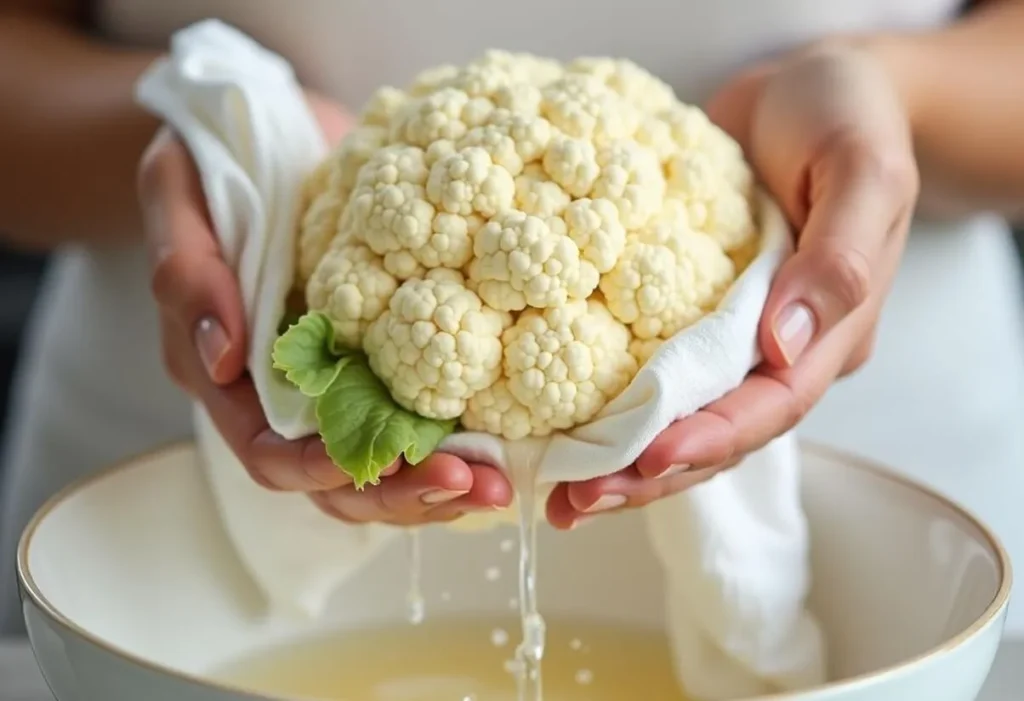Introduction
If you’re looking for a healthy, gluten-free, and low-carb alternative to traditional pizza dough, cauliflower pizza crust is a fantastic choice. Loved by health enthusiasts and foodies alike, it’s versatile, delicious, and perfect for those on vegan, keto, or gluten-free diets. But one question often arises: how do you make cauliflower crust crispy?

A crispy crust can make all the difference, turning your pizza into a satisfying masterpiece rather than a soggy disappointment. The key challenge lies in controlling moisture, selecting the right ingredients, and mastering proper cooking techniques. Many home cooks struggle with soft or crumbly results, but with the right approach, you can achieve a golden, crunchy crust that holds up to your favorite toppings.
In this guide, we’ll walk you through the essential steps, tips, and recipes to create the perfect cauliflower pizza crust. From vegan options to troubleshooting soggy results, you’ll find everything you need to turn your pizza night into a crispy success.
Why Choose Cauliflower Crust?
Cauliflower pizza crust is more than just a trend—it’s a smart choice for anyone looking to enjoy pizza without the guilt. This low-carb, gluten-free, and vegan-friendly option caters to a wide variety of dietary needs while maintaining a delicious taste and texture. Whether you’re watching your calorie intake or avoiding gluten, cauliflower crust has you covered.
One of the biggest benefits is its role in weight management. By swapping traditional dough for a low-calorie cauliflower pizza crust recipe, you can enjoy your favorite comfort food while cutting back on carbohydrates and calories. It’s also packed with nutrients like vitamin C, fiber, and antioxidants, making it a healthier base for any pizza.
Cauliflower crust is versatile enough to fit into various diets. For keto enthusiasts, it provides a low-carb base that complements high-fat toppings like cheese and avocado. Vegans can use plant-based binders like flaxseed or chia seeds to create a crust that aligns with their lifestyle.
For those short on time, frozen cauliflower crusts offer a convenient alternative. Brands like Caulipower and others make it easy to enjoy this healthier option without the prep work. With the right cooking methods, even frozen options can be made deliciously crispy.
Choosing cauliflower crust is a simple yet impactful way to enjoy pizza while supporting your health and dietary goals.
Tips for a Crispy Cauliflower Pizza Crust
Achieving a perfectly crispy cauliflower pizza crust may seem daunting, but with the right techniques, you’ll be enjoying a crunch-worthy base in no time. Whether you’re following a quick cauliflower pizza crust recipe or a more detailed method, the key is to focus on moisture removal, proper binding, and baking techniques.
1. Removing Moisture
Cauliflower is naturally high in water, which can make the crust soggy if not handled correctly. Start by ricing your cauliflower using a food processor, grater, or pre-riced cauliflower from the store. Steam the riced cauliflower briefly, then let it cool.

Once cooled, transfer it to a clean kitchen towel or cheesecloth and squeeze out as much water as possible. This step is critical—removing excess moisture creates a firm, crispy base. You’ll be amazed at how much water comes out!
2. Binding Ingredients
A proper binder is crucial for holding your crust together. Eggs are the traditional choice, but for a vegan option, flaxseed or chia seeds work just as well. Mix your binder with the dried cauliflower, along with seasonings and a bit of almond flour for added structure.
For those seeking simplicity, try a 3 ingredient cauliflower pizza crust: cauliflower, eggs (or flaxseed), and cheese (or nutritional yeast for a vegan alternative).
3. Baking Techniques
Pre-baking your crust is essential for achieving crispness. Spread the dough evenly on parchment paper or a silicone baking mat to avoid sticking. Bake the crust at 400–425°F (200–220°C) for 15–20 minutes before adding toppings. This helps dry out any remaining moisture and creates a solid foundation. After adding toppings, return it to the oven and bake until the edges are golden brown.
Why Is My Cauliflower Pizza Crust Soggy?
A soggy cauliflower crust is one of the most common frustrations for home cooks. Here’s why it happens and how to fix it:
- Not Removing Enough Moisture
If the cauliflower isn’t thoroughly dried, the crust will retain water, making it soft and pliable instead of crisp. Always squeeze out as much liquid as possible during preparation. - Incorrect Baking Temperature
A temperature that’s too low won’t evaporate moisture efficiently. Always bake at 400°F or higher to ensure water is eliminated and the crust sets properly. - Overloading with Toppings
Too many toppings, especially watery ones like tomatoes or zucchini, can weigh down the crust and reintroduce moisture. Use light, evenly distributed toppings for the best results.
By addressing these common mistakes, you’ll be able to transform a soggy crust into one that’s firm, crispy, and pizza-night ready.
Vegan Cauliflower Pizza Crust Recipe
Making a delicious and crispy vegan cauliflower pizza crust is easier than you think! This recipe skips animal-based ingredients, making it perfect for plant-based eaters. Follow these detailed steps to create a crust that’s as flavorful as it is crispy.
Ingredients:
- 1 medium head of cauliflower (about 4 cups riced)
- 2 tablespoons ground flaxseed (or chia seeds) + 5 tablespoons water (for flax egg)
- 3 tablespoons almond flour (or another gluten-free flour)
- 2 tablespoons nutritional yeast (optional, for cheesy flavor)
- 1 teaspoon garlic powder
- 1 teaspoon dried oregano
- 1/2 teaspoon salt
- Optional: Fresh herbs (basil, parsley) for added flavor

Instructions:
- Prepare the Cauliflower
- Preheat your oven to 400°F (200°C).
- Rice the cauliflower using a food processor or grater. You should have about 4 cups of finely riced cauliflower.
- Steam the cauliflower for 5 minutes or microwave it in a large bowl for 4–5 minutes until tender. Allow it to cool.
- Remove Excess Moisture
- Once the cauliflower has cooled, place it in a clean kitchen towel or cheesecloth. Squeeze out as much water as possible. This step is critical for achieving a crispy crust.
- Prepare the Flax Egg
- In a small bowl, mix ground flaxseed with water. Let it sit for 5 minutes until it forms a gel-like consistency.
- Mix the Dough
- In a large bowl, combine the cauliflower, flax egg, almond flour, nutritional yeast, garlic powder, oregano, and salt. Mix well to form a dough.
- Shape the Crust
- Line a baking sheet with parchment paper or use a silicone baking mat. Spread the dough into a thin, even circle or rectangle about 1/4 inch thick.
- Pre-Bake the Crust
- Bake the crust for 20–25 minutes, or until the edges start to brown and the center feels firm.
- Add Toppings and Bake Again
- Remove the crust from the oven, add your favorite vegan toppings, and bake for an additional 10–15 minutes. Look for golden edges and bubbly toppings.
Explore another approach to crafting cauliflower-based crusts.
How Do You Make Cauliflower Crust Crispy in the Oven?
The oven is your best tool for achieving a crispy cauliflower crust. Here are some key techniques:
- Use Parchment Paper: Lining your baking sheet with parchment prevents sticking and allows the crust to brown evenly. Silicone mats work well too.
- Bake at the Right Temperature: Always bake at 400–425°F (200–220°C) for optimal crisping. Lower temperatures won’t dry the crust properly.
- Thin and Even Layers: Spread the dough evenly to ensure the entire crust cooks at the same rate. Uneven layers can lead to soggy or burnt spots.
- Pre-Bake Thoroughly: Pre-baking removes moisture and sets the crust before adding toppings. Don’t skip this step!
With these tips, your vegan cauliflower pizza crust will turn out golden, firm, and perfect for piling on your favorite toppings.
How to Make Cauliflower Crust Crispy Without an Oven
While an oven is a traditional choice for baking cauliflower pizza crust, there are several alternative methods that can achieve equally crispy results. Whether you’re using an air fryer, a grill, or a stovetop, the key lies in managing heat and moisture properly. Here’s how to do it:

1. Air Fryer Method
Air fryers are excellent for creating a crispy crust due to their circulating hot air.
- Step 1: Preheat the air fryer to 375°F (190°C).
- Step 2: Line the air fryer basket with parchment paper or lightly grease it.
- Step 3: Place your prepared cauliflower dough in the basket and spread it evenly into a thin layer.
- Step 4: Air fry for 10–15 minutes, checking halfway through to ensure even browning. Flip if needed.
- Step 5: Add toppings and air fry for an additional 5–7 minutes.
2. Grill Method
Grilling gives the crust a smoky flavor and a crisp texture.
- Step 1: Preheat the grill to medium-high heat (about 400°F or 200°C).
- Step 2: Place the dough on a piece of aluminum foil or a grill-safe pizza stone.
- Step 3: Grill with the lid closed for 8–10 minutes until the edges are golden.
- Step 4: Flip the crust carefully, add toppings, and grill for another 5–7 minutes.
Discover creative ideas for plant-based pizza crust alternatives.
For additional inspiration, explore other nutritious cauliflower-based recipes that are both delicious and healthy.
3. Stovetop Skillet Method
Using a stovetop skillet is another effective option.
- Step 1: Heat a non-stick or cast-iron skillet over medium heat and lightly grease it.
- Step 2: Place the cauliflower dough in the skillet, spreading it into a thin layer.
- Step 3: Cook for 5–7 minutes on one side until golden brown. Flip carefully.
- Step 4: Add toppings, cover with a lid, and cook on low heat for an additional 5–7 minutes to melt the toppings.
Is Cauliflower Crust Supposed to Be Crunchy?
The crispness of cauliflower crust is largely a matter of personal preference. Some people enjoy a softer texture reminiscent of flatbread, while others prefer a crispy, cracker-like crust. The crispness depends on the following factors:
- Moisture Removal: Thoroughly squeezing out the water from the cauliflower ensures a firmer crust.
- Thickness of the Dough: A thinner crust will crisp up more easily, while a thicker one may stay softer.
- Cooking Method: Oven baking, air frying, or grilling tends to yield crispier results compared to stovetop cooking.
Ultimately, cauliflower crust can be tailored to your taste by adjusting the preparation and cooking methods. Experiment to find the texture that works best for you!
Best Frozen Cauliflower Pizza Crust Options
Frozen cauliflower pizza crust is a convenient and time-saving option for busy days. These pre-made crusts eliminate the need for ricing, squeezing, and mixing, making it easy to enjoy a healthier pizza base with minimal effort. Popular brands like Caulipower and Trader Joe’s offer ready-to-use crusts that are widely available and versatile.
Pros of Frozen Crusts:
- Convenience: No preparation required—just bake and top.
- Consistency: Pre-made crusts are uniform in size and texture.
- Time-saving: Ideal for quick meals or last-minute pizza nights.
Cons of Frozen Crusts:
- Crispness Challenge: Frozen crusts may not achieve the same level of crunch as homemade versions without proper preparation.
- Ingredient Awareness: Some brands may include added starches or preservatives, so always check the label.
Tips for Crisping Up Frozen Cauliflower Pizza Crust:
- Preheat Properly: Always preheat the oven to the temperature specified on the package. A hot oven is essential for crisping the crust.
- Bake on a Pizza Stone: Using a pizza stone or steel can help absorb moisture and create a firmer crust.
- Avoid Overloading Toppings: Too many toppings can weigh down the crust and make it soggy.
- Flip the Crust: For extra crispness, flip the crust halfway through baking before adding toppings.
Read more about avoiding soggy crusts with ready-made bases.
How Do You Make Caulipower Crust Crispy?
Caulipower is one of the most popular brands for frozen cauliflower pizza crust, and with the right approach, you can enhance its crispness at home.
- Use a Preheated Pizza Stone: Place the crust directly on a preheated pizza stone for even heat distribution and a crunchier bottom.
- Follow Baking Instructions: Bake the crust on the middle rack at 425°F (220°C) for 10–12 minutes before adding toppings.
- Add Toppings Sparingly: Use lighter toppings to avoid introducing extra moisture.
- Broil for a Golden Finish: After baking, switch to the broil setting for 1–2 minutes to achieve crispy edges.

By following these tips, you can turn store-bought options like Caulipower into a pizza experience that rivals homemade versions.
Frequently Asked Questions
How Do I Make My Crust More Crispy?
Achieving a crispy crust requires attention to specific techniques and adjustments. Factors like managing moisture, baking at the right temperature, and choosing the proper toppings all play a crucial role. However, there’s much more to explore when perfecting the art of crispiness.
For a detailed step-by-step guide and additional tips, check out the full article here: How Do I Make My Crust More Crispy?.
Why Is My Cauliflower Pizza Crust Soggy?
A soggy cauliflower crust is a common issue that can result from factors like retained moisture or incorrect baking techniques. Problems such as incomplete moisture removal, low baking temperatures, or skipping essential pre-baking steps may all contribute to this challenge.
To dive deeper into why this happens and learn how to fix it effectively, read the full article here: Why Is My Cauliflower Pizza Crust Soggy?.
Common Issues and Quick Fixes
If your cauliflower crust isn’t turning out as expected, consider these troubleshooting tips:
- Undercooked Crust: Increase baking time or ensure the crust is spread thin for faster, even cooking.
- Sticky Crust: Use parchment paper or a silicone baking mat to prevent sticking.
- Soft Edges: Broil the crust for 1–2 minutes after baking to achieve crispy edges.
- Cracking or Crumbling: Add a sufficient binder (like eggs, flaxseed, or chia) and avoid over-drying the cauliflower during the wringing process.
Mistakes to Avoid:
- Skipping moisture removal.
- Overloading toppings.
- Using a low baking temperature.
By addressing these common pitfalls, you’ll ensure your cauliflower crust is consistently crispy, delicious, and pizza-ready every time.
Conclusion and Final Tips
Creating the perfect cauliflower pizza crust may require a bit of practice, but with the right techniques, you can achieve consistently crispy results. Key takeaways include thoroughly removing moisture from the cauliflower, pre-baking the crust to set its foundation, and using the right tools like parchment paper or a pizza stone for even cooking.
How do you make cauliflower crust crispy? It all comes down to mastering these essentials and tailoring the process to your preferences. Whether you’re using an oven, air fryer, or even a grill, the steps outlined in this guide provide a reliable framework for success. Don’t forget that lighter toppings and proper temperature settings can make a significant difference in the final texture.
Experiment with these methods, try variations like vegan or store-bought crusts, and make adjustments to suit your taste. Every attempt brings you closer to pizza perfection. Share your results and inspire others to discover the delicious versatility of cauliflower crusts.
With these tips in hand, your next pizza night is bound to be a crispy success!
Related Aticles:

